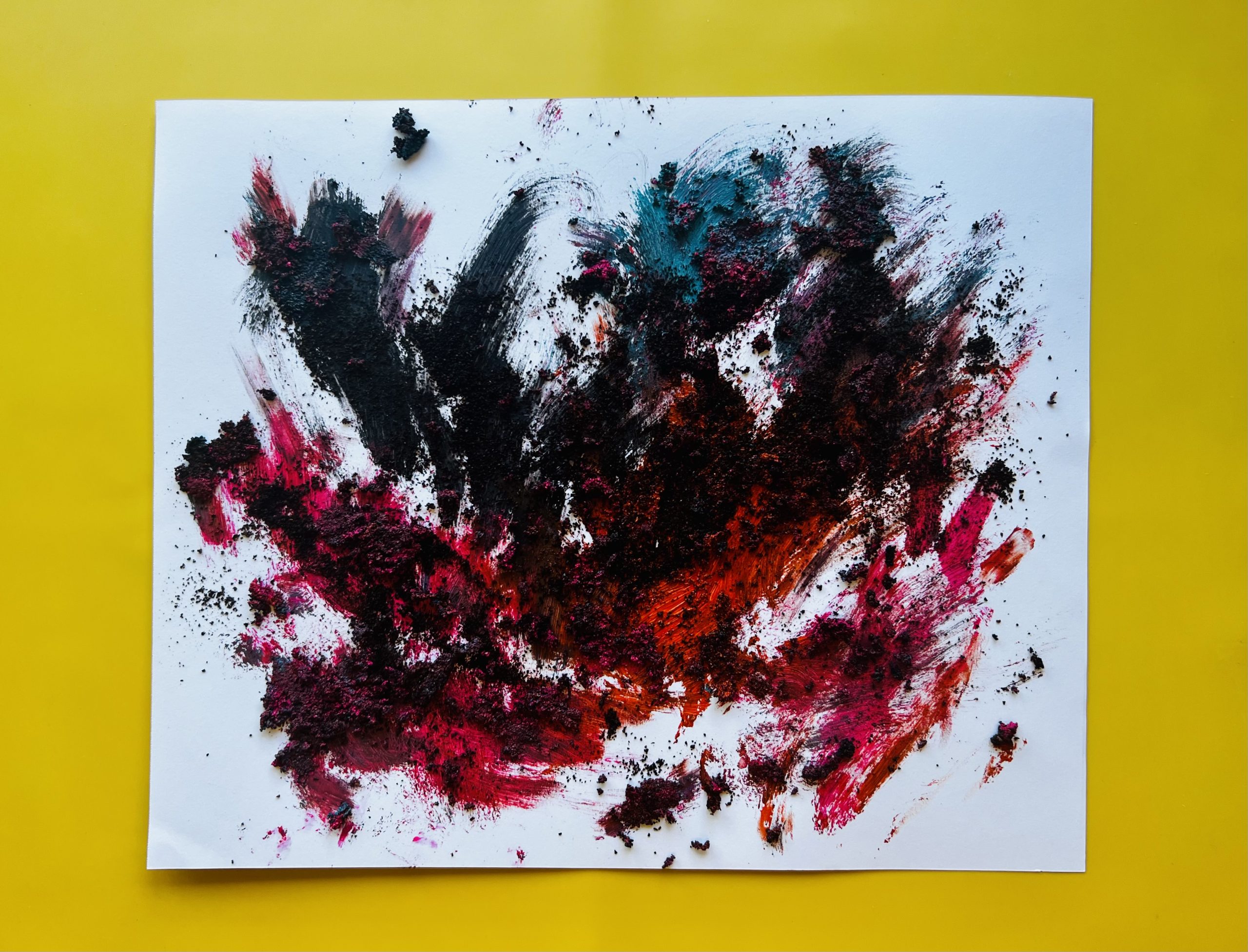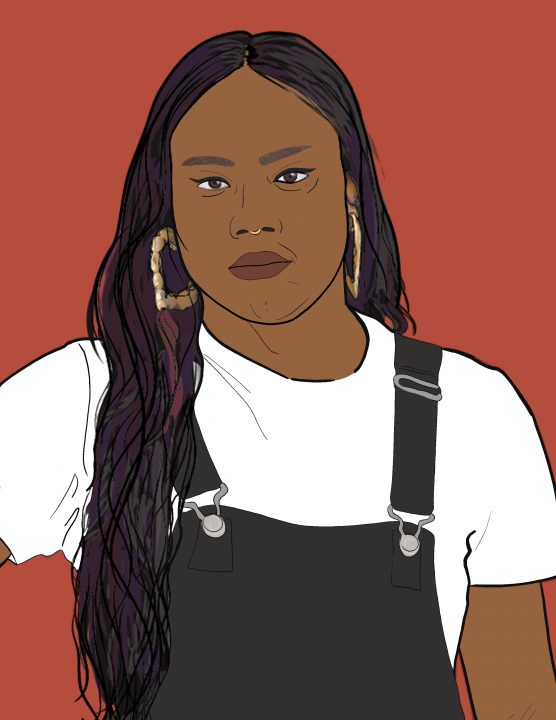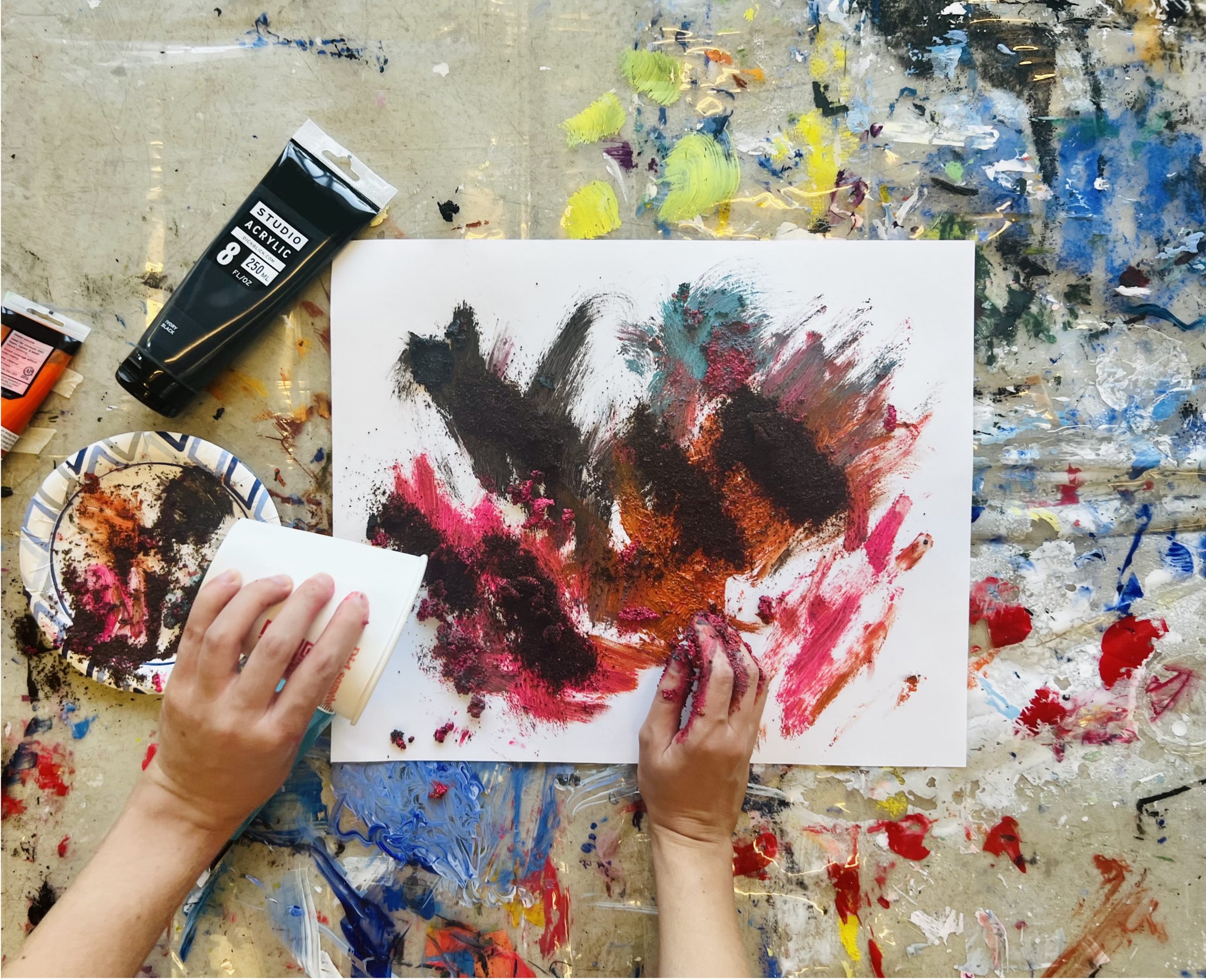Make Your Own Meditation

Have you ever had really big feelings? Making art helps many people think about their big and difficult emotions and find ways to heal. In this project, use your entire body to create an artwork that helps you meditate on those big feelings.
Time: 1 hour +
Skill Level: Advanced
Topic: Process Performance
Note: Many contemporary artists work with complex ideas and issues in their art making. This project is inspired by an artwork in which Kiyan Williams takes aim at the complicated, messy, and often violent history of the founding of the United States. This artwork may be trauma-inducing for some people. Practice self care. If you feel overwhelmed: take a deep breath, take a pause, or talk to someone you trust.
Also, this is not a neat and tidy project. Work in a space you don’t mind getting messy, such as outside. If you are working inside, you can place a piece of cardboard inside a large plastic bin or place a large sheet on the floor under your canvas.
Materials:
- Background such as cardboard or cardstock
- Multiple pieces of paper for sketching and experimenting
- Mark-making tools (pen, pencil, marker, etc.)
- Messy materials that are important to you in a personal way (glitter, sand, ground up crayons, paint, soil, or anything else that’s significant to the artist)
- Newspaper, drop cloths, or something to protect your work area
Look Closely

Watch this video of artist Kiyan Williams at work. What is going on? Describe Williams’ actions. What are they doing? Stand up and give yourself enough space to move. Recreate the motions you see the artist making. How do the movements make you feel?
In the video, the artist is moving and throwing material at a canvas. What do you think the artist is throwing? How would you describe the composition (shape) they are creating?
Williams is throwing soil onto the canvas forming it into a shape that looks similar to the United States of America. All these actions the artist makes are a performance. Performance art can look like many things, but it always incorporates live action into the artwork.
Kiyan Williams titled this work Meditation on the Making of America. Meditation is a practice of calming your mind and body; people often meditate in a seated position with their eyes closed. Williams calls their performance of throwing soil a meditation. The actions that Williams performs seem quite different than a seated meditation.
Williams grabs soil from a long, rectangular box. The box is the shape and size of a coffin. Inside the box is a mask of the artist’s face created from the same soil.
As Williams throws this soil, they are reflecting on the difficult history of the United States. Sometimes their performance includes violent movements to mimic violence committed against Black people in the United States. Williams often uses soil as a material and a symbol in their art. In this video work you just viewed, Williams uses soil to represent how Black people helped shape the making of America. The artist chooses soil from significant historical places, such as Jamestown, Virginia, because it was a place where slave traffickers first sold Black people into slavery in what is now the United States. To traffic a person means to buy and sell people, against their will.

ABOUT THE ARTIST Kiyan Williams (b. 1991) an American artist from Newark, New Jersey. They use soil to make most of their art! (Why does Kiyan use their? Learn more about gender pronouns here.) Williams paints, sculpts, digs, and even eats soil to make art. Williams shared this with Hirshhorn Kids: “When I think about being an artist, it’s not about making a thing. It’s about a curious perspective. I always was a curious kid. I asked a lot of questions. I wanted to get at the root of things.” What are you curious about? If you could ask Williams a question about their artwork, Meditation on the Making of America, what would you ask?
Want to learn more? Read more about Kiyan Williams’s life and work.
Make It!
Express your feelings and make art with your entire body. Create your own process performance inspired by Kiyan Williams’s Meditation on the Making of America.
As Williams gathers, grabs, and throws soil, they are meditating on the mistreatment of Black people in the United States. Art can help us process complex emotions. What’s on your mind? How could you express your feelings by making art?
- Scribble while you meditate. Grab a piece of paper and a mark-making tool for meditation scribbling. Give yourself 5 to 10 minutes to scribble. Let your feelings flow into your hand. Don’t think about what you’re drawing; let your hand guide you.
You might draw something abstract (like a big blob of lines). Or you might draw something you’re thinking about, like a sketch of flowers. Try not to worry about what your drawing looks like. It’s more about giving yourself space. Focus on your emotions instead of the actual work of art you draw. Note: If this exercise is too much, take a break and talk to an adult you trust.
- What’s something you’ve been thinking about a lot? Maybe it’s something that’s upset you, or something you’re feeling anxious about. You might also just explore what’s on your mind today. Write or draw about your thoughts. As you draw, name the emotions you feel and write them down. How might you show these emotions like frustration or disappointment with your entire body? How would you move? For our model project, we wanted to express our frustration with bus and train delays. Younger artists might focus on a transition, such as a new school year; or on something that’s bothering them, such as a disagreement with a friend or family member.
Note: If this exercise is bringing up too many tough feelings, take a break and talk to an adult you trust.

- Gather materials. You’ll want materials with a consistency that you can throw, drop, or move with. You might use a liquid material like paint or water, or a loose material such as sand or glitter. Williams used a messy material, soil, to convey the messiness of the founding, or making, of the United States. What materials do you want to use?
You’ll need an assortment of the following:
- A background surface, such as cardboard or cardstock
- Liquid materials, such as paint or water
- A variety of loose materials, such as glitter, sand, ground up crayons, soil, or anything else that’s significant to you
- A surface to mix materials on, like a plate, cup, lid or paint palette
- Newspaper, drop cloths, or something to protect your work area
- Paper towels to easily clean hands after art-making with sticky and wet materials

- Contain the mess. Whether you are working outside or inside, you’ll want to protect the ground, floor, or table from the mess. For our model project, we placed a shower curtain on an indoor concrete floor that could be easily washed afterward. Be sure to check with an adult before starting a messy project.

- Prep your significant process materials. Kiyan Williams’ used soil as a primary material in the Meditation on the Making of America. Williams often chooses their soil from significant places from history, such as Black burial grounds, old churches, and schools. What materials are meaningful to you? Choose and mix process materials until you have your own unique mixture.
Note: You might gather soil or another material from somewhere that’s significant to you or mix materials on hand to make your own substance. If you make your own material, think about how you can use color or texture to emphasize your emotions. Always ask an adult for permission before gathering materials from public spaces.

- Experiment with your process. Think about the video of Williams performing that you just watched. What were some of the actions they used? You probably noticed them throwing and shaping their materials. Sometimes, when something makes you angry or feels wrong, it’s hard to put your feelings into words. Actions like throwing can make you feel better and help process emotions.
What movements do you want to repeat for your process? Make sure you have enough space in your work area and practice a few different motions with your process material on a practice sheet of paper. You might try dropping materials, throwing them, scooping them, or another repeatable motion that feels freeing to you.
Note: Let your emotions guide your actions, but be mindful of others around you. Try to make sure your materials hit your canvas!

- Project your feelings onto your work. Once you’ve chosen your materials and physical process, you can start making your own performance piece. Place your background surface in your maker space and start performing your process. Allow your emotions to flow over you as you start your process. Note: If this exercise is too much, take a break and talk to an adult you trust. Teacher tip: before step 6, have students flip over their emotion sketches from step 1 and tape them to their art-making surface.

- Process, reflect, and repeat. Continue performing, experimenting and shaping your work until you feel content. You may choose to mix your liquid and loose materials directly on your background surface. Your work will likely be very wet and heavy when complete, so find a safe place for it to dry. While your work is drying, reflect on your project. How did you feel before, during, and after your meditative artmaking? Would you do anything differently? Why, or why not?

- Title your work. Once you’re finished making and storing your work, give it a name. We titled our model project Metro Mornings.
